Suddenly discovered a 1.8m tall creature like a giant penguin
New fossil analysis shows that Plotopteridae in Japan have many similarities with the extinct giant penguin in New Zealand.
About 62 million years ago, up to 9 species of penguins lived in tropical New Zealand. Some are about the same size as modern penguins, but others like Crossvallia waiparensis can grow to a height of 1.6 m, about the size of an adult woman.
Meanwhile, Plotopteridae appeared on Earth more than 30 million years ago. Their fossils are found only at certain locations in Japan and North America. Some Plotopteridae specimens are even bigger than giant penguins with a height of 1.8m.

Image reconstructing a species of Plotopteridae. (Photo: Mark Witton).
Although living nearly 30 million years apart in time and 5,000 km in geographical distance, these two ancient birds have striking similarities. New research conducted by experts at the Canterbury Museum in New Zealand shows that in addition to the same wing shape, both species possess a long beak with a nostril-like opening, as well as a chest and bone structure. Shoulders convenient for diving.
" Plotopteridae look like penguins, swim like penguins and probably also eat like penguins, but they are not penguins, " lead author of the study Paul Scofield, manager of the Canterbury Museum described in published in the June 29 issue of the journal Evolutionary Research and Zoology.
Despite many physical similarities, Plotopteridae and giant penguins are not related. Plotopteridae is closely related to a number of other seabirds such as coke, sea buzzard and crazy bird.
"This is an example of what we call evolutionary convergence , when different lineage organisms develop similar morphological traits under similar environmental conditions , " co-authored. author of the study Vanesa De Pietri, curator of the Canterbury Museum.
Like penguins, scientists believe that Plotopteridae also evolved from ancestors flying in the sky, hunting by plunging from the air into the water. Over time, they develop swimming skills and adapt to life below the surface of the ocean and oceans.
- Detection of giant penguin fossils in New Zealand
- Ancient penguin discovered in New Zealand
- Detecting giant bones as high as 3m
- Find the big penguin record
- Fool 40 years: The 4.5-meter penguin walking on the Florida coast is just a prank
- 'Monster monster' is a hideous giant eye like a disk washed into America?
- Approaching a population of 9,000 emperor penguins
- Huge giant squid by bus can hide under deep sea
- Why don't penguin's feet get cold?
- Giant iceberg kills 150,000 penguins
- Malaysia discovered the skeleton of the 3-5m tall giant
- The man 'both tall and tall' is unique in medical history
 Discovered an ancient centipede fossil 99 million years old
Discovered an ancient centipede fossil 99 million years old Discovered bat-like dinosaurs in China
Discovered bat-like dinosaurs in China Discovered a 200-year-old bronze cannon of the coast
Discovered a 200-year-old bronze cannon of the coast Discover 305 million-year-old spider fossils
Discover 305 million-year-old spider fossils